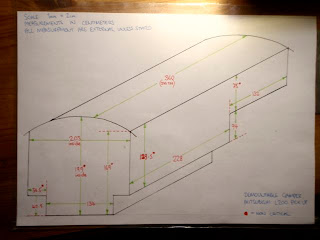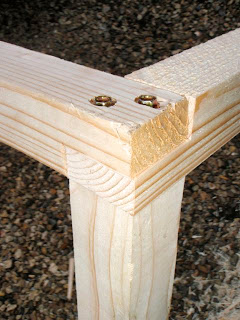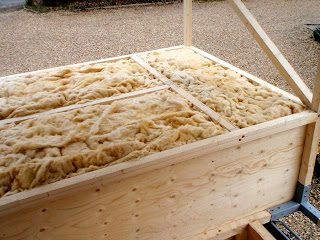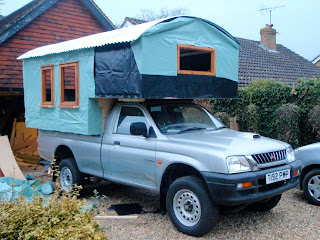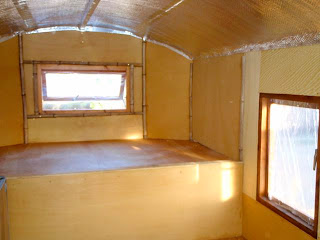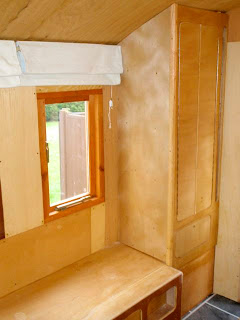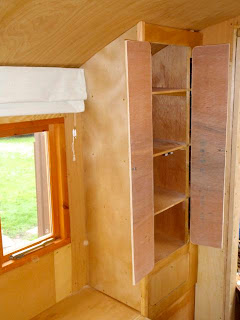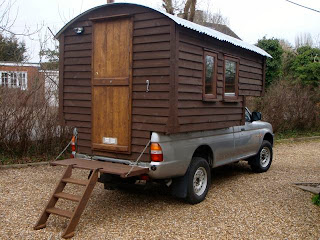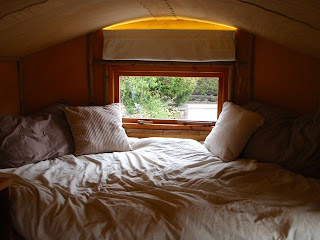First I made some detailed measurements of the truck and drew up some plans just to show the dimensions. I created a quick sketch so that I at least had something on paper! HaHa, this was the only drawing of the whole project. The rest simply came from my creative flow in the moment (and some nights lying awake half dreaming about the possibilities.)
I pretty much made it up as I went along, I was not working from any plans but a creative vision which I just let flow through me.
My favourite and relevant building quote is:
“I just get the bullet out of the gun and then I run after it to get it to hit the right spot”
Lloyd House – A builder featured in Lloyd Kahn’s book – Builders of the Pacific Coast.
(A series of books which I highly recommend and have been a massive influence and inspiration.)
The jacking points for the legs (being demountable) needed to be of steel box section construction to receive the jacks. These were the first things I made. The 50mm box section will accept 50mm timber to extend into the frame. See below.
This is their positioning within the frame having been primed and painted:
Here is one fitted with the timber and bolted into place. You can see the hollow box section facing out from the vehicle. This will accept the jacking leg.
You can see the steel jacking points on the overhanging corners of the floor pan of the camper unit here:
Once the floor pan was completed in a shape to fit around the wheel arches of the loading bay of the truck I started constructing upwards to create the walls to support the roof. I always like to build a roof at the earliest convenience because it offers shelter from the elements for the remainder of the build.
The roof is corrugated tin. I met a farmer who has a machine from the second world war that bends curves from flat sheets. It was used to make air rade shelters and huts. It’s clearly still going strong today!
Some examples of my joins using coach screws:
The first insulation to go in is for the cavity under the bed (over the cab.) See below. I always use loose rock wool insulation in horizontal spaces because it’s super cheap (subsidised by the government, thank you very much.) For vertical insulation I tend to choose solid, rigid insulation boards to save from it settling down in the cavity over time. Celotex is a brand name of a super high rated insulation that I would recommend (I used this in the roof.) Polystyrene board is also good and much cheaper. Neither are very ecological as a one off packaging, but I feel as insulation that will last many many years that it is more justifiable.
I added some more triangulation into the frame and inserted the salvaged recycled timber window frames.
I skinned the whole shell in recycled PVC plastic sheeting as a damp course. This will stop general moisture and rain from finding its way into the structure. A super cheap and very important step!
This was when the first cladding went on. I used feather edge board that’s been treated. It’s very cheap and easy to work with. The cladding both inside and out offers huge strength to the frame, effectively triangulating every shape to stop any lateral movements.
Here’s a photograph of the 50mm of insulation being fitted into the cavities between the timber framing.
Being a tin roof (good conductor) the insulation will prove to be very important to keep the camper cool in the sun and warm at night. First I skinned it with a foil lined air bubble sheeting which has a very high rating for it’s size and weight. It’s also a moisture barrier. I sealed all the edges with a foil ducting tape as well. The purpose for sealing it so well is to stop warm humid air inside the camper (breathing, cooking etc.) from finding it’s way into the ceiling cavity and coming in contact with the cold metal tin roof at night. This would cause a lot of condensation which would drip down to the walls and cause damp and eventually rot. Again, things like this are very important to think about. Without proper construction like this a build could be condemned in as little as a couple of years.
After the foil lining 50mm of Celotex was fitted into the roof cavity. You can also see the beginnings of the bamboo trim of the interior.
Here is a 50mm underfloor insulation layer.
Having built the door frame, I started construction on the door. Doors are rather complicated to build. They have to be strong and secure and they must fit within a few millimetres of precision.
It’s a stable door wich means the top can be openend separately which is nice for privacy and security. The door’s fitted with a closable vent in the bottom and a domestic Yale lock. It’s very solid and secure.
The interior was lines with 3mm hardwood ply. It’s lightweight and looks fantastic.
The beautiful grain in the ceiling is a joy to explore when I’m lying in bed.
As for mounting the camper onto the truck I fabricated six of these steel brackets. They are lined with foam so as not to damage the mounting rails on the camper.
There are 12mm steel coach bolts that are located through structural elements of the camper, they have metal spreading plates on the inside to make them as strong as possible. They line up with the side mounting rails of the truck and with the bulkhead behind the cab. They then do up with locking nuts to hold the camper on securely.
Here is a photo of the unit being demounted.
The beautiful trim on the front is waiting for some gypsy style art work.
BEHIND THE SCENES
There’s lots of technical bits and pieces that go into making a camper a home. Gas and water plumbing, electrical systems and ventilation.
Here are two 85ah deep cycle batteries. These are going to be the auxiliary batteries for the camper unit. They are wired together in parallel to give 170ah total and remain at 12volts. This is a pretty decent power capacity for a portable system.
On the roof are mounted two 100 watt solar panels. Being a curved roof they having slightly different aspects. The good thing about this is that it increases the chances of one facing south when parking randomly!
The power from the solar panels leads down to the silver box on the left. This is a charge controller. It monitors the PV (solar) power and the batteries status to deliver optimum charge characteristics and to avoid damaging over charge scenarios. It’s an MPPT controller (maximum power point tracking) which basically means it optimises the PV output voltage and amperage to deliver the maximum watts (power.) They are more expensive but will give you maybe 10% or more juice from your system.
The blue box on the right is the inverter. This creates 240volts AC from the 12volts DC for running domestic appliances.
There’s also an auxiliary charging circuit from the vehicles electric system. When the engine is running the auxiliary batteries in the camper unit are charged and the fridge is run. (The fridge uses a lot of electricity so when parked up camping it is run from the gas supply. Ironic, cooling from a flame… magic.) If the camper were to be in a guaranteed full summer sunny location the electric system could run the refrigeration but it would be quiet taxing.
Here is a small PV computer that’s mounted externally from the electric locker. This displays all sorts of valuable information about what the system is doing. The small black switch just to the right activates the inverter. This saves having to leave it on all the time (they have a small background current drain even when there’s no load being used. It’s not much but it’s worth turning it off. Every little helps!)

This is the utilities locker. 50litres of water, 170ah of 12volt battery storage and 7kg of butane gas all live in here. The white bucket is an emergency use sawdust compost toilet. This is only really an option in a weekend van where you have a base at home to process the waste. (Unless you want to be regularly digging large holes in the woods which is the only other ethical way to dispose of the sawdust/ waste mix. Simply dumping it is not good.) There’s heaps (excuse the pun) of highly recommended information in Joeseph Jenkins book “Humanure – a guide to composting human manure.”
So, here she is completed. When driving the steps store inside and the rear veranda folds and locks upright forming the tailgate. It also offers even more security as it prevents the door from opening.
The finished interior, complete with “warm white” LED tape lighting
You’re welcome to contact me if you have any questions

